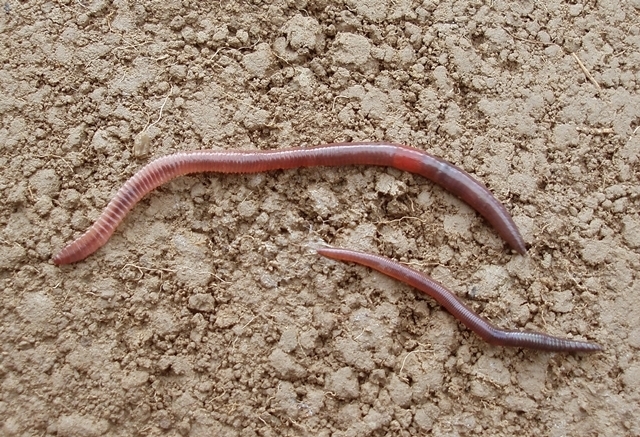Lumbricus rubellus: Difference between revisions
No edit summary |
mNo edit summary |
||
| (11 intermediate revisions by 2 users not shown) | |||
| Line 1: | Line 1: | ||
''Lumbricus rubellus'', also commonly referred to as the red [[earthworm]], redhead worm, and red wriggler is a species of [[earthworm]]. It is referred to as this due to its reddish, brown color. Red earthworms are known as efficient composters and also tend to be a popular choice as bait for fishing. | ''Lumbricus rubellus'', also commonly referred to as the red [[earthworm]], redhead worm, and red wriggler, is a species of [[earthworm]]. It is referred to as this due to its reddish, brown color. Red earthworms are known as efficient composters and also tend to be a popular choice as bait for fishing. | ||
[[File:Redhead.jpg|thumb|640px|right|Close up photo of Lumbricus rubellus on top of soil]] | [[File:Redhead.jpg|thumb|640px|right|Close up photo of Lumbricus rubellus on top of soil]] | ||
==Taxonomy== | ==Taxonomy== | ||
| Line 9: | Line 9: | ||
'''Genus:''' Lumbricus | '''Genus:''' Lumbricus | ||
==Overview== | ==Overview== | ||
''Lumbricus rubellus'' is a medium sized (10-15 cm) worm that is partially pigmented and epi-endogeic. The mean biomass of ''Lumbricus rubellus'' is reported to be 1.89 g. | ''Lumbricus rubellus'' is a medium sized (10-15 cm) worm that is partially pigmented and epi-endogeic. The mean biomass of ''Lumbricus rubellus'' is reported to be 1.89 g.<ref name="NBII">NBII & ISSG. 2011, March 9. Lumbricus rubellus https://www.iucngisd.org/gisd/species.php?sc=1711</ref> ''Lumbricus rubellus'' is a very important species for commerical fishing bait as it has a small size and natural scent which can be picked up by fish. Because of this small size, fisherman tend to favor ''Lumbricus rubellus'' as a bait for small fish.<ref name="Red">Red Wrigglers vs. Night Crawlers: Whats the difference? 2023, May 11. https://unclejimswormfarm.com/red-wigglers-vs-nightcrawlers-whats-the-difference</ref> ''Lumbricus rubellus'' is also a great species for breaking down organic waste. In natural and agricultural ecosystems, red earthworms provide ecological services, including improving [[soil]] [[properties]] and increasing plant production.<ref name="NBII"></ref> | ||
[[File:Lumbri.jpg|thumb|256px|left|Photo of Lumbricus rubellus in a petri dish<ref name="Hoffmeister">Lumbricus rubellus Hoffmeister, 1843, Søborg, Denmark, 23 April 2016: https://commons.wikimedia.org/wiki/File:Lumbricus_rubellus_%2826533505231%29.jpg</ref>]] | |||
==Habitat== | |||
Lumbricus rubellus is commonly found in coniferous forests. The red earthworm is native to Europe, but has since been introduced to North America. They have been seen to thrive in regions with compact, and highly moist soil. They feed on surface litter, but burrow and produce casts in the upper mineral soil layer, so they are closely in relation with [[plant roots]]. Cave-dwelling behavior has been seen in Alabama, Georgia, South Carolina, and Tennessee. Since they are not native to these locations, they may cause negative effects. They have the ability to disrupt the organic layer by consuming and mixing the F and H soil layers.<ref name="NBII"></ref> By doing this, they could be favoring invasive plant species, while also harming native species. | |||
==References== | ==References== | ||
< | <references /> | ||
Latest revision as of 18:28, 3 April 2025
Lumbricus rubellus, also commonly referred to as the red earthworm, redhead worm, and red wriggler, is a species of earthworm. It is referred to as this due to its reddish, brown color. Red earthworms are known as efficient composters and also tend to be a popular choice as bait for fishing.

Taxonomy
Kingdom: Animalia
Phylum: Annelida
Class: Clitellata
Order: Haplotaxida
Family: Lumbricidae
Genus: Lumbricus
Overview
Lumbricus rubellus is a medium sized (10-15 cm) worm that is partially pigmented and epi-endogeic. The mean biomass of Lumbricus rubellus is reported to be 1.89 g.[1] Lumbricus rubellus is a very important species for commerical fishing bait as it has a small size and natural scent which can be picked up by fish. Because of this small size, fisherman tend to favor Lumbricus rubellus as a bait for small fish.[2] Lumbricus rubellus is also a great species for breaking down organic waste. In natural and agricultural ecosystems, red earthworms provide ecological services, including improving soil properties and increasing plant production.[1]

Habitat
Lumbricus rubellus is commonly found in coniferous forests. The red earthworm is native to Europe, but has since been introduced to North America. They have been seen to thrive in regions with compact, and highly moist soil. They feed on surface litter, but burrow and produce casts in the upper mineral soil layer, so they are closely in relation with plant roots. Cave-dwelling behavior has been seen in Alabama, Georgia, South Carolina, and Tennessee. Since they are not native to these locations, they may cause negative effects. They have the ability to disrupt the organic layer by consuming and mixing the F and H soil layers.[1] By doing this, they could be favoring invasive plant species, while also harming native species.
References
- ↑ 1.0 1.1 1.2 NBII & ISSG. 2011, March 9. Lumbricus rubellus https://www.iucngisd.org/gisd/species.php?sc=1711
- ↑ Red Wrigglers vs. Night Crawlers: Whats the difference? 2023, May 11. https://unclejimswormfarm.com/red-wigglers-vs-nightcrawlers-whats-the-difference
- ↑ Lumbricus rubellus Hoffmeister, 1843, Søborg, Denmark, 23 April 2016: https://commons.wikimedia.org/wiki/File:Lumbricus_rubellus_%2826533505231%29.jpg